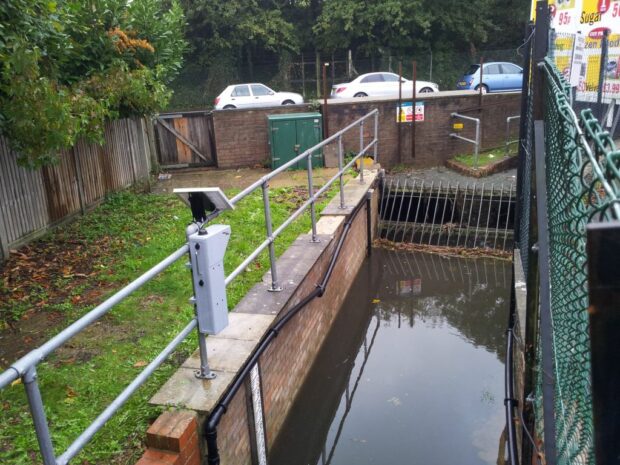
As we mark COP27 ‘Energy Day’, Dave Bonner, Flood Resilience Advisor, explains how his work alone has saved over 40 tonnes of carbon locally and over 600 tonnes nationally, a year.
I’ve worked for the Environment Agency for more than 30 years, a job that I love. Based on the South coast, I’ve always been involved in flood resilience. That means planning and coordinating the Environment Agency’s response to floods to minimise the distressing impact they can have on people’s lives and property.
 One area of this work that people might not think about is the amount of travelling we do every day to inspect river screens. These screens prevent debris like branches and rubbish from blocking drainage channels (culverts). Sadly, they can get blocked, especially after heavy rainfall. This can cause flooding or make flooding worse, so it’s important to keep them clear. Routine weekly inspections of just one screen can involve a journey of 60 miles. During a flood, this can increase to 180 miles as the screens need to be checked around three times every day. As a flood typically lasts 3-5 days, this would result in a total inspection journey of around 540-900 miles! This means more time lost and fuel consumed as a result.
One area of this work that people might not think about is the amount of travelling we do every day to inspect river screens. These screens prevent debris like branches and rubbish from blocking drainage channels (culverts). Sadly, they can get blocked, especially after heavy rainfall. This can cause flooding or make flooding worse, so it’s important to keep them clear. Routine weekly inspections of just one screen can involve a journey of 60 miles. During a flood, this can increase to 180 miles as the screens need to be checked around three times every day. As a flood typically lasts 3-5 days, this would result in a total inspection journey of around 540-900 miles! This means more time lost and fuel consumed as a result.
In 2015 I had the honour of completing an MSc in Crises and Disaster Management, sponsored through work. I used this opportunity to evaluate an idea I had to use radio operated cameras to remotely monitor flood defence structures like these river screens, with the aim of cutting carbon emissions, staff time and money.
I worked with a company to design a special camera that would do the job. It ended up being a GPRS (General Packet Radio Service) camera with infrared illuminator for night shots. It’s fully green, running exclusively off solar power. It doesn't need a fixed telephone line or mains connection – vital given the often-remote rural locations we were faced with.

As we went on, we managed to design the kit so that it could be supplied directly to our teams to install on site, reducing costs and time to install. We can now view these river screens and other flood structures from our mobiles and office IT, and in some cases local communities have direct access (see an example here). This has helped reassure the community, acting as a second pair of eyes.
So where are we now? Initially I ran the project locally on the South coast, but the benefits and savings spoke for themselves. I'm so proud that we now have over 100 sites across my local area of Hampshire, Isle of Wight and Sussex giving a carbon saving of 43 tonnes of CO2 per year (to put this into context the average car generates 120kg of CO2 per year). And even more impressive, we’ve now installed over 1500 cameras countrywide saving 645 tonnes per year.
Each webcam on a single river screen saves thousands of miles and hours of staff travel time, 0.5 tonnes CO2 per year, £325 in fuel costs, reduced wear and tear on our fleet vehicles, and enables us to react more quickly during periods of heavy rain or flooding, releasing staff time to concentrate on more environmental outcomes.
Find out more about the Environment Agency’s plan to reach net zero by clicking here.

1 comment
Comment by Nissi Nwaozuzu posted on
Hi there! I love this article and all the hard work that has gone into the project to make it happen.
We can now view river screens and other flood structures from our mobiles and office IT, as well as give local communities direct access, which is fantastic.
It's great that this has also given a second pair of eyes for reassurance to the community.
I think it's incredible how far this project has come since it was first running on the South coast, with over 100 sites spread across Hampshire, Isle of Wight, and Sussex alone - not to mention the 1500 cameras installed countrywide, which have saved 645 tonnes per year in carbon emissions!
Plus, each webcam saves thousands of miles and hours of staff travel time and £325 in fuel costs.
It's a great example of how technology can reduce carbon emissions, saving time and money and benefiting the environment.
Moreover, it's incredible that this project also helps with flood prediction - enabling us to react quickly during periods of heavy rain or flooding, giving staff more time to concentrate on environmental outcomes.
This is an impressive feat, and I'm sure it will continue to positively impact the country for many years to come!
Overall, this article was truly inspiring, and I enjoyed reading about all the hard work that has made this a success.
Congratulations on such a fantastic accomplishment!